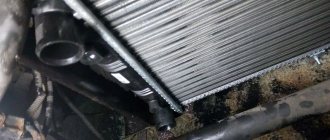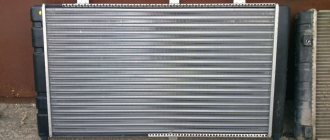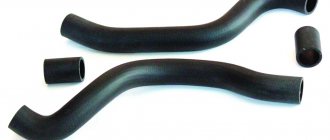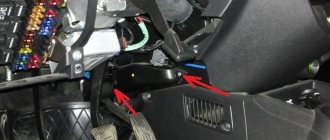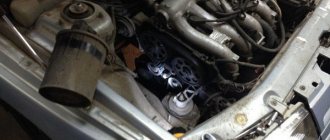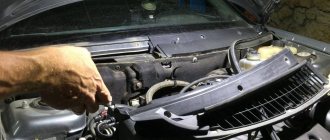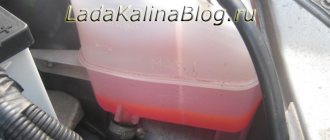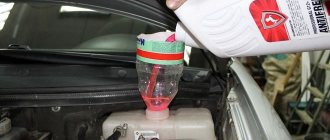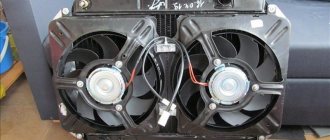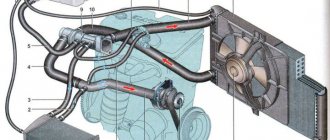Minimum and maximum coolant volume
One of the main questions of car owners is: how many liters of antifreeze should I fill? According to the official technical documentation for Russian-made Lada Priora cars, the required volume of antifreeze is 7.84 liters. For full operation of the power unit, you can fill 6 liters each; this option is suitable for the winter period. However, it is best not to deviate from the regulations and fill in the required amount of liquid so that no problems arise.
Each antifreeze is divided into classifications, and it can be distinguished even by color if there is no label, for example. So, in our country, red antifreeze is predominantly poured - the so-called carboxylate. Regardless of the type, it is important to know how many liters of antifreeze to fill and follow this rule.
Removing air pockets
Malfunctions in the cooling system after replacing antifreeze may occur due to an air lock. There are two ways to remove it.
Loosen the clamp and remove the heating pipe from the throttle assembly. Unscrew the reservoir cap, cover it with a clean rag and blow into the neck until antifreeze comes out of the tube. After this, return the pipe to its place and tighten the clamp well.
Start the engine and run it to increase the pressure in the cooling system. Stop the engine and, without removing the cap from the tank, remove the pipe from the throttle heating. Keep an eye on the tube. As soon as antifreeze begins to come out of it, return the pipe to its place and tighten the hose with a clamp.
Be careful when performing all work, as the antifreeze in the system can be very hot. To avoid the appearance of air locks in the system, during the process of replacing the coolant on the Lada Priora, press on the radiator hoses from time to time.
Installation of a new radiator in a Lada Priora with air conditioning
Replacing the heater radiator in a Priora car with air conditioning is a fairly simple process. The latter unit appeared only in newer cars, in particular, Priors began to be equipped with a HALLA or Panasonic climate control system. Thanks to the new component, you can replace any part of a non-working stove only by dismantling the frill, getting rid of the windshield wipers, the stove itself or the vacuum brake booster.
If a motorist wants to understand how to remove the heater radiator on a Priora with air conditioning, he must start by removing the sound insulation located in the engine panel. After this, you should dismantle the power unit air filter hose and remove the seal, which is located near the radiator hoses. Then you should drain the coolant and lift the radiator up towards the mechanic.
Article number and cost of antifreeze for Priora
According to factory standards, coolant of different brands cannot be mixed in Lada Priora. The Lada-A40 brand is suitable for Priora, its catalog number is: 88888100005082. The cost of the liquid is approximately 550 RUR. rub. for 5kg. There is also a list of acceptable liquids:
- Antifreeze G-48;
- Macra Cool Stream liquid Standard/Premium;
- 2 types OZh-40 Tosol-TS/OZh-65 Tosol-TS.
OZH-K Tosol-TS;
What types of car malfunctions can occur due to antifreeze?
When the coolant begins to drain, the owner of the Lada Priora should think about why this is happening. Antifreeze leaks often occur due to mechanical damage to the cooling system. In the worst case scenario, the engine overheats and the cylinder head gasket burns out.
The car owner noticed that antifreeze was constantly flowing, reasons:
- Leak between block and cylinder head. In this case, you can tighten the bolts better.
- When the radiator is damaged. You can try to replace it, but there are times when only repairs are required.
- The water pump has become unusable. The situation can be corrected by replacing the pump.
- The pipes are damaged. Initially, you need to tighten the clamps; if the problem does not go away, you can replace the hoses and pipes with new ones.
- The expansion tank of the automobile cooling system is damaged. There is only one option - replace the tank.
- Malfunctions can also be short-term in nature:
- There is scale on the cooling jacket; it can also be seen on the pipes and on the walls of the radiator. Flushing the system will help. Next, fill in new high-quality coolant.
- The existing antifreeze circulates poorly through the system. In certain cases, the pump, and in some cases the entire water pump, needs to be replaced.
- When the car owner first notices a low coolant level, he needs to top it up to the level. If the leak becomes regular, the system needs to be checked for leaks.
How to replace the radiator of a Priora stove without air conditioning
In winter, as you know, car enthusiasts turn on the stove to avoid freezing.
Its normal operation ensures a comfortable temperature inside the car, and this, in turn, is the key to safe driving. However, there are times when this unit stops supplying warm air. The reasons can be very different, for example, problems with the radiator. Many people, including owners of Lada Priora, both equipped with air conditioning and without it, encounter malfunctions of this kind. In some cases, it will only take a minute to fix the problem because you just need to replace the blown fuse. But there are situations when more serious repair work, such as replacing a radiator, cannot be avoided. However, there is nothing particularly complicated here. Everything can be done with your own hands - you just need the appropriate desire and a little time.
Choosing coolant for Lada Priora. What does AvtoVAZ recommend?
AvtoVAZ recommends filling the Priora with factory fluid and not mixing it with antifreeze and antifreeze of other brands.
Approved coolant types include:
- OZH-K Tosol-TS
- OZh-40 Tosol-TS
- OZh-65 Tosol-TS
- Antifreeze G-48
- Felix Carbox G12
- Cool Stream Standard
- Cool Stream Premium
- G-Energy Antefreeze
- Antifreeze Sintec, etc.
A complete list of recommended coolants can be found in the operating instructions for the Lada Priora car.
Replacing the radiator of a heating device in a Lada Priora car
Almost every motorist who owns a domestic vehicle discovers a malfunction of the car’s heating unit in the winter. After all, only with the onset of severe cold does a person begin to think about how to avoid freezing while driving a car. Naturally, everyone uses a stove for this. However, what should those for whom this very device has ceased to function properly do? After all, only the heater can ensure that the cabin maintains a normal temperature, allowing for comfortable movement. In this article we will look at only one reason why the heating device stops working, we will learn about the principles of repairing and replacing the heater radiator installed in a Lada Priora car.
If the motorist is sure that it is necessary to replace the heater core, it may take a lot of time to eliminate the faulty object, since most likely, in the process it will be necessary to replace not just a blown fuse, but to carry out more serious repair work. True, you should not immediately despair because of your ignorance; the material contains detailed instructions to help everyone understand how to replace the stove radiator in a Priora with and without air conditioning.
Mixing liquids
The type of coolant is indicated on the packaging. The letter G with a two-digit number and pluses indicates the type of antifreeze, the letters TL indicate antifreeze.
Under no circumstances should you mix antifreeze and antifreeze.
Antifreezes G11 and G12 have different additives: in G11 they create a protective film, and in G12 they eliminate rust. It is unknown how additives will behave when interacting, so mixing liquids of these categories is not recommended.
G11 and G13 contain different base alcohols (ethylene glycol and polypropylene glycol, respectively), so they cannot be mixed categorically.
Antifreezes of classes G12, G12+ and G12++ are made on the basis of ethylene glycol, they contain both organic and inorganic additives of the same nature, so mixing them is permissible.
Coolant compatibility is shown in the table below.
VAZ online stores, discounts for site users
- Accessories
- Spare parts
- Tuning
- Body kits
- Cases
- Studio
- Carbon tuning
- Flocking
Online stores for VAZ accessories
Online stores for VAZ spare parts
xn—2111-43da1a8c.xn—p1ai
How to remove an air lock on a Priora
On a car, malfunctions occur in the cooling system, and an air lock may form. To remove air from the system, you need to use its hoses. This is done in one of two ways. In each case, you need to wait until the power plant has completely cooled down, and only then begin to troubleshoot the problem.
It is best to wear thick gloves before work to avoid burns. Warm up the engine a little and be sure to turn off the car. Remove the tube and clamp from the heating when antifreeze flows. Put everything back in its rightful place and tighten the clamp again. Air will escape under the resulting pressure.
A device such as the throttle assembly clamp needs to be loosened, then the tube must be removed from the heating. Next, open the lid of the special expansion tank of the cooling system located in the engine compartment, cover the neck with a clean rag and blow through it properly. You will see air coming out. You need to tighten the cap when the coolant appears directly.
If, after you have replaced the coolant, you notice that the engine cooling system is not functioning correctly, then it is quite possible that the problem is an air lock.
First way:
- Loosen the clamp and disconnect the pipe from the heating of the throttle assembly.
- We unscrew the lid of the cooling tank, cover it with a clean rag and blow into the neck until antifreeze starts flowing from the removed pipe.
- As quickly as possible, put the pipe in place and tighten the clamp.
Second way:
- We warm up the engine a little so that the pressure in the cooling system increases slightly, and then turn it off.
- Without removing the coolant tank cap, disconnect the pipe from the throttle body heating.
- After antifreeze or antifreeze starts coming out of the tube under pressure, immediately put the coupler in its place and tighten it with a clamp.
Attention! Be careful as the coolant being drained may be very hot at this point.
Direction of coolant flow in the thermostat housing and cover
: 1 — supply from the cylinder head cooling jacket; 2 - to the heater radiator; 3 - to the throttle assembly heating block; 4 - from the expansion tank; 5 - to the supply pipe of the coolant pump; 6 — from the radiator of the cooling system; 7 - to the radiator of the cooling system
From the pump, liquid under pressure is supplied to the engine cooling jacket, and from there to the thermostat housing. Two thermostat valves - main and bypass - redistribute fluid flows in the cooling system. On a cold engine, the main valve closes the channel in the thermostat cover connecting the lower (outlet) radiator hose with the pump supply pipe. The bypass valve of the thermostat is open, and the flow of liquid from the engine cooling jacket enters through the thermostat housing into the supply pipe of the coolant pump, bypassing the radiator of the cooling system - a small circulation circle. As the engine warms up, at a fluid temperature of 85±2 °C, the thermostat valves begin to move, closing the bypass channel and opening the main channel, passing the fluid flow through the radiator of the cooling system. At a liquid temperature of about 102 °C, the bypass valve closes completely, and the main valve opens to its full stroke - 8 mm, and the liquid enters the radiator of the cooling system, where it gives off heat to the surrounding air. The movement of fluid through the engine cooling jacket, thermostat housing and radiator of the cooling system forms a large circulation circle.
: 1 - plate; 2 — bypass valve spring; 3 - spring; 4—cylinder with heat-sensitive filler; 5 - main valve; 6 — rod; 7 - bypass valve
Fluid circulates constantly through the heater radiator and the throttle body heating unit and does not depend on the position of the thermostat valves.
Location of the coolant temperature indicator sensor
(for clarity, the radiator hoses and ECM wiring harness blocks are disconnected): 1 - cylinder head; 2 — coolant temperature indicator sensor; 3 — engine control system coolant temperature sensor; 4 — thermostat housing; 5 - thermostat cover
: 1 — rubber cushion of the lower fastening; 2 - outlet pipe; 3 — hole for the side fastening of the fan casing; 4 — left tank; 5 — supply pipe; 6 — steam outlet hose pipe; 7 — bushing of the upper fastening; 8 — pin for the upper fastening of the fan casing; 9 — right tank; 10 — radiator drain plug; 11 — stud of the lower fastening of the fan casing
The radiator consists of two vertical plastic tanks (the left one with a baffle) and two horizontal rows of round aluminum tubes passing through the cooling plates. The bases of the tubes are connected to the tanks through rubber gaskets. The liquid is supplied through the upper pipe and discharged through the lower. Above the inlet pipe there is a thin pipe for the steam removal hose. There is a drain plug at the bottom of the right tank. A plastic casing with an electric fan is attached to the radiator.
Fan with casing assembly
: 1 — electric motor wiring harness; 2 - casing; 3 - impeller; 4 - electric motor
The fan maintains the thermal operating mode of the engine and is switched on via a relay based on a signal from the engine control system controller.
Coolant temperature gauge sensor
To monitor the coolant temperature, a temperature gauge sensor is screwed into the engine cylinder head in the instrument cluster. content .. 170 171 172 173 174 175 176 177 178 179 ..
Replacing the heater radiator on a Lada Priora
If the stove on your Lada Priora starts blowing cold air instead of hot air, you should pay attention to the heater radiator. There are already discussions on our website about why the stove on a Priora does not work, but we still decided to publish additional material on replacing the heater radiator with our own hands.
Features of the design of the stove on the Lada Priora
Main elements of the heater:
– heater heat exchanger (radiator), designed to heat the air entering the passenger compartment with the heat of the engine cooling liquid; – an electrically driven fan (supercharger), providing a controlled supply of outside air to the heater dampers; – a damper for the air temperature regulator coming from the heater into the passenger compartment, the position of which determines the amount of air passing through the heat exchanger of the heater, and the amount of outside air passing bypassing the heat exchanger; – air heating distributor dampers 4, which distribute the air entering the cabin from the heater through air ducts 2, 6, 8 and 9 or for blowing the windshield.
If antifreeze or antifreeze is leaking from the stove, then the radiator is leaking and requires replacement.
Let us recall that in the previous article we looked at how to replace a Priora heater fan with your own hands.
Replacing the stove (heater) radiator on a Priora
– drain the antifreeze. – remove the heater. - Prepare a Phillips screwdriver.
Video. How to remove the stove on a Lada Priora
Replacing the heater on a Priora with your own hands:
1. First of all, you need to unscrew the 3 screws that hold the heater radiator.
2. Then remove the radiator from the stove body.
Installing the stove radiator will be done in the reverse order; this requires a little sleight of hand. I spent about 50 minutes on this operation.
Step-by-step instructions for replacing antifreeze in Priora yourself
Replacing the coolant yourself requires some tools and items, check out the list before you get started:
- 13th key;
- Phillips screwdriver;
- Capacity 10 l.;
- Coolant – 8l.
Before the antifreeze is replaced on the LADA Priora, it is, of course, necessary to drain the old antifreeze. First you need to wait until the “engine” and the coolant itself cool down, this is required in order to avoid getting burns.
A procedure such as replacing the coolant is carried out in the following sequence:
- We drive the car into the pit and stop it accordingly.
- Remove the negative terminal from the battery.
- We remove the crankcase protection of the power unit.
- Remove the cap of the expansion tank of the cooling system.
- We substitute the previously prepared container under the “engine”.
- We unscrew the drain plug, a key will help with this.
- The plug should be tightened when all the antifreeze has completely drained out.
- We transfer the container with the drained antifreeze under the radiator and unscrew the cap on it, from here it is also necessary to drain the antifreeze.
- Close the plug after the coolant has drained.
- Disconnect the throttle body heating hose.
- Fill in new antifreeze within the MIN/MAX marks.
- We install the throttle body heating hose in place. Tighten the pipe properly.
- Check the steam outlet pipe for leaks.
System parts and components
The design of the Lada Priora engine cooling device is quite simple and inherent in all injection versions. The coolant circulates in circles - large and small. Let's look at the details of the “cooler” assembly in more detail.
Radiator and electric fan
The radiator and electric fan ensure a constant engine temperature within the range of 87-103 degrees Celsius so that the engine does not overheat. On the first engine models, a three-row cooler of copper construction was installed. But, after unsuccessful tests, the designers decided to change the radiator to a three-row aluminum one.
The electric fan is turned on by a control unit, which regulates the engine temperature using a coolant temperature sensor. Temperature data is read from the cooling jacket and sent to the ECU, which turns the main fan on and off.
A malfunction of the fan and cooling radiator leads to poor circulation and insufficient cooling of the system. In this case, the motor may overheat.
If this is coupled with a faulty thermostat, this will lead to overheating of the motor, which will lead to more serious problems.
Thermostat
Provides transfer of coolant flows from a small to a large circle and vice versa. So, the thermostat opens at a temperature range of 60-70 degrees. This is one of the most important parts of the engine, since it is what regulates the efficient and rapid warming up of the engine, as well as the normal operation of the coolant system.
When the engine warms up, the thermostat is in the closed position and coolant circulation is ensured in a small circle without the participation of the radiator. After the thermostat opens, the liquid begins to circulate in a large circle, which ensures effective cooling thanks to the radiator.
A malfunction of the thermostat leads to the fact that the engine begins to heat up, since it is in a closed state and often this malfunction is accompanied by frequent activation of the electric fan. Changing the thermostat is easy; to do this, you just need to drain the coolant to a level below the part and unscrew the housing. The product is located under the body.
When replacing, it is worth changing the sealing rubber.
Water pump
The water pump or pump serves to circulate coolant throughout the system. Failure of this element leads to loss of fluid and overheating of the power unit. Typically, wear on the bearings inside the product will cause it to seize, causing the water pump to start leaking.
Why does antifreeze leave the cooling system?
Experts recommend cleaning the system after each replacement. When you change antifreeze to antifreeze, or vice versa, switch from antifreeze to antifreeze, be sure to clean the system. What you may need for this:
- Plastic funnel and hose.
- A packet of regular citric acid.
- Distilled water (15 liters for Priora).
- A brush, sized to fit into the neck of a 5-liter bottle.
Please note that if the coolant is not cloudy, then you can only get by with distilled water. Otherwise, be sure to add citric acid. A good working fluid begins to lose color over time, that is, it becomes discolored, and a contaminated fluid always becomes cloudy.
Cleaning of the LADA Priora cooling system should be carried out after removing the air lock. Let water flow through the system through the open pipe. Using a brush, you can clean the expansion barrel separately. After this procedure, damage to the tank body is clearly visible. After cleaning the system is complete, you can add antifreeze.
If you notice that the liquid in the tank is constantly leaking and is below normal, it means that there is a leak in the system that urgently needs to be fixed. Regardless of how much fluid is lost, it is necessary to conduct a thorough diagnosis of such system parts as:
- expansion tank pipes;
- steam exhaust pipe from the radiator;
- throttle body and thermostat hose;
- all clamps.
Diagnostics of the throttle hose and thermostat Priora
If the connections are ok, check the tank housing, radiator and thermostat, it is possible that the problem lies there. In addition, sometimes antifreeze leaks out of the pump hole. If, after examining all of the above components, the leak problem remains, and the antifreeze also goes away, it is recommended to contact specialists who will conduct a more thorough diagnosis.
Signs that indicate the need to replace a part
Experts believe that the main factors that indicate a faulty water pump are:
- coolant leaking from the housing in the oil seal area;
- wear of the built-in bearing, which is determined by increased noise, humming during operation, or jamming;
- insufficient circulation of the coolant used;
- excessive increase in the temperature of the power unit;
- reducing the level of coolant poured into the system;
- the presence of cracks, chips, chipping of the material of the pulley, housing or impeller of the water pump.
The water pump, as a rule, is a non-repairable component due to its design features
Therefore, experts recommend a complete replacement of this important part.
The water pump for the Lada Priora is completely replaced if it malfunctions
Timing for coolant replacement
In VAZ Priora cars with a 16-valve engine manufactured in 2011 and other years of production, the frequency of antifreeze changes is 75 thousand kilometers. Then the working fluid begins to lose its properties. In addition, the refrigerant that is poured during production is changed every five years, if during this time the car has not traveled 75 thousand km.
The need to change the working fluid can be determined by the following “symptoms”:
- the antifreeze has become dirtier, black, and traces of deposits have appeared in it;
- a refrigerant leak has occurred, as a result of which more liquid will need to be added to the system, and if you do not know what kind of antifreeze was added, then it will have to be changed;
- the presence of deposits and dirt in the expansion tank, this indicates that the substance has lost its properties;
- foam formation in the reservoir under the hood;
- the stove began to work worse in the winter season;
- the engine began to boil.
What does damage cause?
The most common cause is engine overheating. failure will occur in a very short period of time. As a result of overheating, the cylinder block becomes deformed, cracks may appear and the piston may become deformed.
But it is much worse when the piston is completely deformed and makes a hole in the cylinder block. Such a breakdown usually leads to a complete replacement of the damaged engine with a new unit.
Level control and how many liters are needed
To understand how many liters of refrigerant need to be poured into the Priora 16 valves, refer to the car’s operating instructions. The technical manual states that the cooling system capacity is 7.8 liters. Therefore, exactly the same amount of refrigerant is poured into it.
The Prio Dvenar channel published a video in which it showed how the procedure for replacing the coolant in Priora is carried out.
Fluid level diagnostics must be performed on a cold engine. Open the hood and locate the antifreeze expansion tank. You will see two marks on the tank - MIN and MAX, the volume of liquid should be normal between them. If there are no marks on the tank, then it has a horizontal edge that shows the normal level of antifreeze. In order for the system to effectively cool the power unit, it must not be filled with less than the required amount of refrigerant.
Expansion tank device
The manufacturer installs expansion tanks produced by Plastik LLC on the Lada Priora car. They are made of translucent white plastic. A scale showing the coolant level must be applied to the front wall of the tank.
The Max and Min marks show the level of antifreeze in the tank
The tank is closed with a lid, which simultaneously measures the antifreeze pressure in the cooling system. The lid is located on the neck at the top of the tank. It is made of plastic and, for its part, reliably seals the cooling system.
Few people know, but a pair of valves are built into the tank lid. Each of them operates under certain conditions, which allows you to compensate for the amount of coolant at the moment it boils or cools.
Expansion tanks made in Russia are distinguished by their strength and durability. Their cost depends on the design features of the case (from 300 rubles and above).
Lada Priora cars are equipped with the simplest domestic coolant tanks
SOD components
The cooling system includes many different parts that are responsible for the correct operation of the system. To understand the purpose of these parts, you need to take a closer look at them.
Cooling radiator
This part is designed to cool antifreeze while the car is moving. As coolant circulates through the radiator it cools and therefore cools the engine block. Inside, the radiator consists of many tubes connected to each other by a snake.
Possible breakdowns:
- Antifreeze leaking from radiator joints;
- Radiator clogged with oxidation products;
Water pump (Pump)
The pump is a pump that circulates liquid through the cooling system. Circulation is ensured by the pump impeller based on the principle of centrifugal force. The pump rotates using the crankshaft through the timing belt.
Possible breakdowns:
- Coolant leaks through the oil seal;
- Wear of ball bearings;
- Impeller failure;
Thermostat
The thermostat is one of the main elements of the Priora engine cooling system. Inside the thermostat housing there is a valve with a thermoelement, which is responsible for opening and closing a large circle. When the coolant is heated to a temperature of 85⁰C, the thermostat valve opens and the liquid begins to pass through the cooling radiator, thereby cooling down and preventing the engine from overheating.
Possible breakdowns:
- Valve jamming in one of the positions;
Expansion tank
The expansion tank is designed to compensate for the expansion of the liquid during heating, as well as the contraction during cooling. It is for these reasons that the amount of liquid in the tank is at an average level.
Possible breakdowns:
- Tank rupture due to a breakdown of the cylinder head gasket;
- Cracks in the tank due to old age;
Expansion tank cap
The main task of the tank cap is not only to close the opening of the coolant tank, but also to relieve excess pressure in the system. It is in the lid that a valve is installed that operates in two positions: pressure release and vacuum release (vacuum). If there were no valve, the pressure in the system would inflate the hoses and rupture the expansion tanks.
Possible breakdowns:
- Valve jamming;
- Loss of tightness;
Cooling Fan
Designed to cool the engine in a traffic jam or when the car is stationary. As you know, the radiator effectively cools the car when there is a headwind, that is, when driving. When stuck in a traffic jam, the cooling of the car is reduced to zero, so a fan is used as an artificial wind, which turns on at a certain temperature and cools the liquid.
Possible breakdowns:
- Fan motor malfunction;
Heater radiator
The heater radiator and the cooling radiator have a similar design, but differ in size and purpose. The purpose of the heater radiator is to heat the vehicle interior. It is installed in the stove body in the engine compartment and has two input and output fittings.
Possible breakdowns:
- Leak at joints;
- Blockage;
Pipes
The pipes are responsible for the circulation of fluid from one part to another throughout the system. They are made of rubber that is resistant to temperature loads; inside each pipe there is a reinforced thread that does not allow the pipe to swell due to pressure in the system.
The cooling system of the Lada Priora is typical for representatives of AvtoVAZ power units - liquid, closed type. It is practically no different from the standard 8-valve power unit.
How to change it correctly?
Next, we will look at how to correctly replace the working fluid of the cooling system in a Lada Priora car with an electronic pedal or with air conditioning. You can change the refrigerant at a service station, but this task is quite simple and anyone can handle it on their own. For the best effect it is necessary, we will talk about this below.
Preparation
Before you begin the process, prepare the following:
- fresh refrigerant in the required volume;
- seal for the drain cover if the old one is worn out;
- set of wrenches;
- clean rags;
- container for collecting used antifreeze.
The Lada Priora Repair and Maintenance channel provided a video that demonstrated the procedure for draining the working fluid from the cooling system.
How to replace antifreeze on a Priora:
- Drive the car into a garage with a pit; you will need a flat surface to perform the work. Wait until the engine cools down; the entire process is carried out cold.
- There should not be high pressure in the cooling system. To reset it, open the hood and unscrew the expansion tank cap. If the engine is hot, coolant may spray out of the hole, so use a rag when opening it.
- Dismantle the plastic protection of the power unit. To remove it you need to unscrew two fasteners on the sides. It is not necessary to dismantle the clamps, but removing them will make the task more convenient.
- If your car is equipped with a transmission with control cables, then it is necessary to dismantle the starter device. To do this, disconnect the negative terminal from the car battery. Press the fastening of the connector with the wiring and disconnect the plug from the output of the traction relay. Remove the protective cap from the nut securing the tip of the wire connected to the positive terminal of the battery. Using a 13mm wrench, unscrew the nut and remove the cable tip from the contact screw on the traction relay. Then use the same tool to unscrew the screws and dismantle the starter device. If the car's transmission is controlled by traction, then there is no need to dismantle the starter.
- Find the drain plug; it is located directly on the cylinder block. You need to place an old bucket or basin under it, into which the used refrigerant will be drained. Unscrew the cap and wait until the liquid comes out of the system. Also unscrew the protective valve under the radiator device; some of the substance will also flow out of it. When the draining is complete, you need to tighten both plugs. Don't forget to check the condition of the seal on the drain cap. If it is worn out or there are traces of defects, the ring must be replaced.
- Assess the condition of the refrigerant drained from the refrigeration system. If there are traces of deposits, wear products, or the liquid as a whole is very cloudy and viscous, it is recommended to flush all components. To do this, pour about 7.8 liters of distilled water into the system through the expansion tank. You can add vinegar or citric acid to it to remove dirt. The use of special cleaning agents is allowed. After filling, the engine starts, you can perform a test drive. Then the procedure for draining the refrigerant from the power unit is repeated. If the liquid is still dirty, then the washing is repeated until it comes out clear.
- Assess the condition of all pipes and lines of the cooling system. If there is damage or signs of leaks, the hoses must be replaced.
- The next step is to pour new refrigerant into the system. To prevent an air lock from appearing in the lines and eliminate air entering the system, it is recommended to slightly loosen the clamp of the pipe connected to the throttle assembly. The hose is then disconnected.
- The cooling system is filled with fresh antifreeze through the filler neck in the expansion tank. New refrigerant is poured in until it comes out of the pipe disconnected from the throttle. When this happens, the line is connected into place and the clamp is securely tightened. Then the refrigerant is added to the system to the required level.
- All previously dismantled components are reassembled in reverse order.
- The engine starts and the journey is carried out. Now you need to once again make sure that the fluid level is correct. Make sure there is no leakage from the drain hole.
Remove the cover on the expansion tank Unscrew the drain valve on the radiator cooling device of the engine Remove the starter from the car by disconnecting all fasteners
Next, we will look at how to correctly replace the working fluid of the cooling system in a Lada Priora car with an electronic pedal or with air conditioning. You can change the refrigerant at a service station, but this task is quite simple and anyone can handle it on their own. For the best effect, it is necessary to flush the cooling system, we will discuss this below.
Replacing the radiator of a heating unit in a Priora that is not equipped with air conditioning
Replacing the heater radiator on a Priora without air conditioning may make sense if warm air has stopped flowing into the cabin, while the heater itself is working. If, in addition to the above problem, there is also a water leak from under the Priora stove, the motorist will have to remove the poorly functioning unit in order to solder the latter. Sometimes repairs are impractical and you have to replace the old device with a new one.
So, first of all, you need to start by removing the negative terminal from the battery. The fact is that the issue here is not only about the safety of the master himself, but also about additional insurance, which allows him to avoid several unpleasant surprises that, if handled carelessly, can arise not only with wiring, but also with electrical equipment.
Replacing the expansion tank
This simple operation is accessible to every self-respecting car enthusiast. To carry it out, it is enough to have the following devices on hand:
Work must be carried out on a cooled engine. This is necessary to avoid burns. First you need to drain the liquid from the tank. To do this, place the Priora on a flat surface. On the main radiator on the right side, along the direction of the car, there is a special lamb in the lower part. This is the drain hole. Place a container under it and unscrew the screw. After this, unscrew the cap from the tank. Only after unscrewing the plug, not before. This will simply allow you to regulate the pressure and maintain cleanliness. Well, it will reduce the loss of tasol.
When all the fluid has drained from the tank, the plug in the radiator can be returned to its place. The rest of the liquid will not interfere. And this will prevent the creation of air locks in the system.
Now you can remove the tasol drive itself. To do this, use a screwdriver to loosen the clamps on the three incoming hoses and disconnect them. Pull the tank out of the mounting groove and insert a new one. Reassemble everything in reverse order. Fill in the drained coolant and warm up the Priora engine. That's all the replacement is.
An interesting option for checking the functionality of the lid. Very useful video:
The water cooling system of VAZ cars of the “tenth” family necessarily includes a plastic expansion tank. When the volume of antifreeze increases as a result of heating, its excess flows into this container. The second function of the element is to remove steam and excess pressure through a plug with a valve. The problem is that on “tens” tanks often fail and car owners have to change them. The replacement procedure is not complicated and can be easily done with your own hands.
How to replace a Lada Priora radiator heater without air conditioning
First of all, let's look at the main elements of the VAZ-2170 heating system. They are, in particular:
The scheme is, in principle, traditional, and there are no particularly complex technical delights here. If you notice that warm air is not flowing into the cabin while the heater is on, you should inspect the entire system. If a radiator leak is detected, the latter will have to be removed either in order to be soldered, or to be replaced with a new one. Let's look at how this procedure can be done with your own hands on a Priora without air conditioning.
The first thing that is recommended to do before starting the main work is to remove the negative terminal from the battery.
Do not neglect this advice, because it is, firstly, about your safety, and secondly, it is additional insurance against a number of different unpleasant surprises with wiring and electrical equipment.
After the car is de-energized, you can remove the windshield trim. It will also be necessary to dismantle the wiper arms, since they will create additional inconvenience during operation. Together with them, we also disconnect the plastic tubes through which liquid from the windshield washer reservoir is supplied to the nozzles. Now you can proceed to removing the decorative trim of the windshield. This is not difficult to do - it is attached using 7 self-tapping screws, respectively, they should be unscrewed.
First you will need to remove the hood seal. Please note that in the middle of the pad there is a screw with which the halves are pulled together. After this, use a screwdriver or knife to carefully pry up the plugs covering the screws and unscrew them. That's it - the cover can be removed.
If everything went well, then you can move on. At this stage, you should remove the sound insulation from the engine compartment. To do this, unscrew the screws with which it is actually attached, and then remove the lining, left and right (the order does not matter). After this, you can move on to the pipes leading directly to the radiator. In order to remove them, you will first need to loosen the retaining clamps. Place a container to drain the coolant first.
Now you can remove all the wires that lead to the heater from the connectors. Having disconnected them, take two keys - 10 and 8 - and unscrew the 4 nuts. The wiring harness should be moved to the side so that it does not interfere, after first removing the holder. After this, we move into the car interior and take a socket wrench size 13. With its help, remove the bracket from the brake pedal, and
move it to the side. That's all - you have free access to the heater radiator. In order to remove it, you need to unscrew 3 screws using a Phillips screwdriver, after which the unit can be easily removed. All work on installing the radiator is carried out in reverse order.
As you can see, there is really nothing particularly difficult here. In order to remove the heater radiator on a Priora without air conditioning yourself, you will need some time (it all depends on your skills) and a minimum set of tools. On the other hand, you save money because you do all the work yourself, rather than turning to specialists at a car service center. Even if you have never encountered this before, figuring out how to remove the Priora radiator will not be difficult. The eyes, as you know, are afraid, while the hands do. It’s probably worth listening to folk wisdom.
